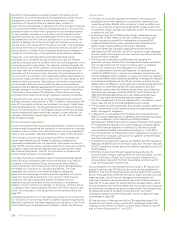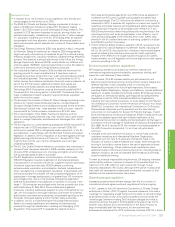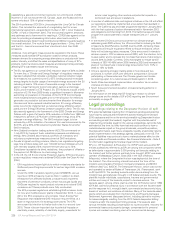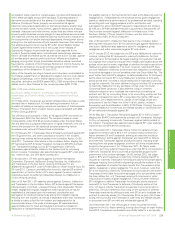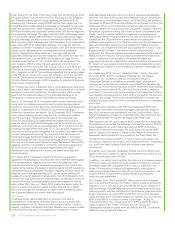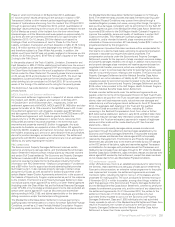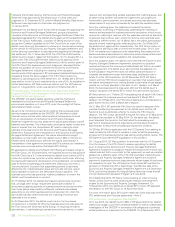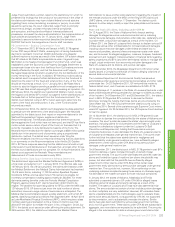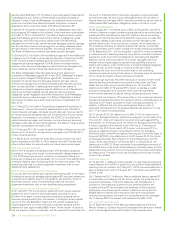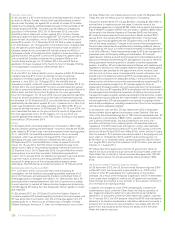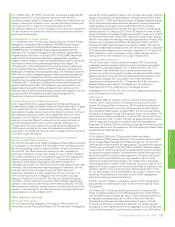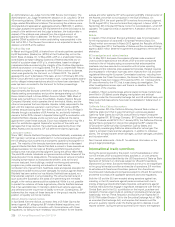BP 2014 Annual Report Download - page 240
Download and view the complete annual report
Please find page 240 of the 2014 BP annual report below. You can navigate through the pages in the report by either clicking on the pages listed below, or by using the keyword search tool below to find specific information within the annual report.
Canadian class action
On 20 July 2012, a BP entity received an amended statement of claim for
an action in Alberta, Canada, filed by three plaintiffs seeking to assert
claims under Canadian law against BP on behalf of a class of Canadian
residents who allegedly suffered losses because of their purchase of BP
ordinary shares and ADSs. This case was dismissed on jurisdictional
grounds on 14 November 2012. On 15 November 2012, one of the
plaintiffs re-filed a statement of claim against BP in Ontario, Canada,
seeking to assert the same claims against BP. BP moved to dismiss that
action for lack of jurisdiction, and on 9 October 2013 the Ontario court
denied BP’s motion. On 7 November 2013, BP filed a notice of appeal
from that decision. On 14 August 2014, the Ontario Court of Appeal held
that the case should be stayed and that the claims made on behalf of
Canadian residents who purchased BP ordinary shares and ADSs on
exchanges outside of Canada should be litigated in those countries, and
granted leave for the plaintiff to amend the complaint to assert claims
only on behalf of Canadian residents who purchased ADSs on the
Toronto Stock Exchange. On 10 October 2014, the plaintiff filed an
application for leave to appeal to the Supreme Court of Canada. Briefing
on that application concluded on 25 November 2014.
Dividend-related proceedings
On 5 July 2012, the federal district court in Houston in MDL 2185 issued
a decision granting BP’s motion to dismiss, for lack of personal
jurisdiction, the lawsuit against BP p.l.c. for cancelling its dividend
payment in June 2010. On 10 August 2012, the plaintiffs filed an
amended complaint, which BP moved to dismiss on 9 October 2012. On
12 April 2013, the court granted BP’s motion and dismissed the lawsuit
for lack of personal jurisdiction and on the alternative grounds of failure to
state a claim and that the courts of England are the more appropriate
forum for the litigation. On 16 June 2013, the court granted the plaintiff’s
motion to amend its decision so as to eliminate the alternative grounds
for dismissal. On 22 November 2013, the plaintiffs filed an additional and
substantially identical action against BP p.l.c. in federal court in New York,
which was transferred to the judge presiding over MDL 2185. BP p.l.c.
moved to dismiss that action on 19 February 2014. On 18 June 2014, the
court dismissed the case on the ground that the courts of England are
the more appropriate forum for the litigation. On 18 July 2014, the
plaintiff appealed that decision to the Fifth Circuit. Briefing on that appeal
concluded on 24 December 2014.
ERISA
On 30 March 2012, the federal district court in Houston in MDL 2185
issued a decision granting the defendants’ motions to dismiss the ERISA
case related to BP share funds in several employee benefit savings plans.
On 11 April 2012, the plaintiffs requested leave to file an amended
complaint, which was denied on 27 August 2012. Final judgment
dismissing the case was entered on 4 September 2012 and, on
25 September 2012, the plaintiffs filed a notice of appeal to the Fifth
Circuit. On 15 July 2014, the Fifth Circuit remanded the case to the
district court in light of new pleading standards recently set forth by the
US Supreme Court. On 18 September 2014, the plaintiffs filed a motion
seeking leave to amend their complaint. Defendants opposed that
motion. On 15 January 2015, the district court granted in part and denied
in part the motion to amend, permitting plaintiffs to amend their
complaint to allege some of their proposed claims against certain
defendants. Plaintiffs filed an amended complaint on 12 February 2015.
Settlements with the DoJ and SEC
On 1 June 2010, the DoJ announced that it was conducting an
investigation into the Incident encompassing possible violations of US
civil or criminal laws, and subsequently created a unified task force of
federal agencies to investigate the Incident. On 15 November 2012, BP
announced that it reached agreement with the US government, subject
to court approval, to resolve all federal criminal charges and all claims by
the SEC against BP arising from the Deepwater Horizon accident, oil spill
and response.
On 29 January 2013, the US District Court for the Eastern District of
Louisiana accepted BP’s pleas regarding the federal criminal charges, and
BP was sentenced in connection with the criminal plea agreement. BP
pleaded guilty to 11 felony counts of Misconduct or Neglect of Ships
Officers relating to the loss of 11 lives; one misdemeanour count under
the Clean Water Act; one misdemeanour count under the Migratory Bird
Treaty Act; and one felony count of obstruction of Congress.
Pursuant to that sentence, BP will pay $4 billion, including $1,256 million in
criminal fines, in instalments over five years. Under the terms of the
criminal plea agreement, a total of $2,394 million will be paid to the National
Fish & Wildlife Foundation (NFWF) over five years. In addition, $350 million
will be paid to the National Academy of Sciences (NAS) over five years.
BP made its required payments that were due in March and April 2013,
January 2014, and January 2015 totalling $1.521 billion. The court also
ordered, as previously agreed with the US government, that BP serve a
term of five years’ probation. Pursuant to the terms of the plea agreement,
the court also ordered certain equitable relief, including additional actions,
enforceable by the court, to further enhance the safety of drilling operations
in the Gulf of Mexico. These requirements relate to BP’s risk management
processes, such as third-party auditing and verification, BP’s oil spill
response plan, training, and well control equipment and processes such as
blowout preventers and cementing. BP also agreed to maintain a real-time
drilling operations monitoring centre in Houston or another appropriate
location. In addition, BP will undertake several initiatives with academia and
regulators to develop new technologies related to deepwater drilling safety.
The resolution also provides for the appointment of two monitors, both
with terms of up to four years. A process safety monitor will review, and
provide recommendations concerning BPXP’s process safety and risk
management procedures for deepwater drilling in the Gulf of Mexico. An
ethics monitor will review and provide recommendations concerning BP’s
ethics and compliance programme. BP has also agreed to retain an
independent third-party auditor who will review and report to the probation
officer, the DoJ and BP regarding BPXP’s compliance with the key terms of
the plea agreement including the completion of safety and environmental
management systems audits, operational oversight enhancements, oil spill
response training and drills and the implementation of best practices. Under
the plea agreement, BP has also agreed to co-operate in ongoing criminal
actions and investigations, including prosecutions of four former employees
who have been separately charged.
In its resolution with the SEC, BP has resolved the SEC’s Deepwater
Horizon-related claims against the company under Sections 10(b) and
13(a) of the Securities Exchange Act of 1934 and the associated rules. BP
has agreed to a civil penalty of $525 million, payable in three instalments
over a period of three years, and has consented to the entry of an
injunction prohibiting it from violating certain US securities laws and
regulations. The SEC’s claims are premised on oil flow rate estimates
contained in three reports provided by BP to the SEC during a one-week
period (on 29 and 30 April 2010 and 4 May 2010), within the first 14 days
after the accident. BP’s consent was incorporated in a final judgment and
court order on 10 December 2012, and BP made its first payment of
$175 million on 11 December 2012, its second payment of $175 million
on 1 August 2013, and the final instalment of $175 million, plus accrued
interest, on 1 August 2014.
BP’s November 2012 agreement with the US government does not
resolve the DoJ’s civil claims, such as those for civil penalties under the
Clean Water Act or claims for natural resource damages under OPA 90.
Neither does it resolve the private securities claims pending in MDL
2185.
US Environmental Protection Agency matters
On 28 November 2012, the US Environmental Protection Agency (EPA)
notified BP that it had temporarily suspended BP p.l.c., BPXP and a
number of other BP subsidiaries from participating in new federal
contracts. As a result of the temporary suspension, the BP entities listed
in the notice were ineligible to receive any US government contracts
either through the award of a new contract, or the extension of the term
of or renewal of an expiring contract.
In addition, the charges to which BPXP pleaded guilty included one
misdemeanour count under the Clean Water Act that, by operation of
law, triggered a statutory debarment, also referred to as mandatory
debarment, of the facility where the Clean Water Act violation occurred.
On 1 February 2013, the EPA issued a notice that BPXP was mandatorily
debarred at its Houston headquarters. Mandatory debarment prevents a
company from entering into new contracts or new leases with the US
government that would be performed at the facility where the Clean
Water Act violation occurred.
236 BP Annual Report and Form 20-F 2014


